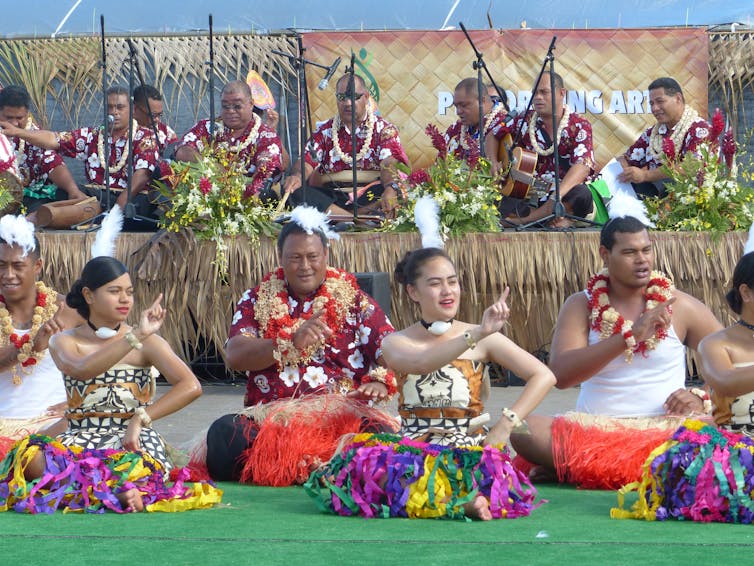Rows of dancers, bodies attired with natural fibres and adorned with fragrant oils and flowers, move in synchronous harmony. They raise their voices in song and affirm connections across the vast seaways of the Pacific.
Watching and listening are delegates and visitors from many islands. All have come to learn, to represent and to connect. Scenes such as this will be a focus when the 13th Festival of Pacific Arts & Culture – known by many simply as FestPAC – kicks off on O‘ahu in Hawai‘i today.
For the next ten days, dancers and singers, carvers and creators, storytellers and orators, scholars and educators will celebrate, demonstrate and reflect on life and culture within the vast and complex Pacific region.
With 28 Pacific nations represented, this year marks the return of FestPAC after a long hiatus due to the COVID pandemic. The eight years since 2016’s event in Guåhan (Guam) have been the longest absence since the festival’s founding in 1972.

Past and present together
Taking place every four years (except for 2020), each event sees a different location and host culture within Oceania. Delegations from most Pacific countries and states come together for an intensive and wide-ranging exchange of art forms and cultural practices.
Past festivals have focused on the endurance of ancestral traditions and legacies, in keeping with FestPAC’s established goals, as well as emphasising the preservation and revival of Indigenous languages.
But there is also an increasing focus on contemporary culture. The festival is known for its eclectic range of art forms, practices and creativity, as well as providing a forum for political ideas about cultural ownership and identity.
Indeed, the inaugural festival in 1972 was in part a response by the South Pacific Commission (now the Pacific Community) to concerns about cultural change in the region.
Described as “the world’s largest celebration of Indigenous Pacific Islanders”, it was aimed at promoting exchange among Pacific communities and cultures.
Each festival is organised around a theme. The first, in Fiji, was about “preserving culture”.
More than entertainment
The sixth festival, in 1992 in Rarotonga, featured a “seafaring heritage” theme. The significance of ocean voyaging has continued to define the festival. A key opening protocol is the dawn arrival of voyaging canoes that have made the crossing from their homelands to the host country.
At the 2016 festival on Guåhan, navigators, voyagers, builders and scholars came together for a special canoe summit that examined and affirmed the remarkable voyaging traditions of the Pacific.
Other festivals have had a focus on the survival of unique art forms and revitalisation of cultural practices. This year, the Aotearoa New Zealand delegation includes the Haumanu Collective, exponents of taonga pūoro, traditional Māori instruments.
Overall, the 2024 festival is looking toward the future with the theme of “Hoʻoulu Lāhui: Regenerating Oceania”. There’s a varied programme of ceremonies and protocol, heritage arts, performing arts, visual arts and symposiums.
But the festival also encapsulates the idea that art and cultural practices are more than just entertainment or ways to communicate aspects of ancestral heritage. They are also vehicles for unification, historical awareness and political resistance.

Political culture
FestPAC delegations have a long history of engaging with current social and political issues, including climate change and decolonisation. Global politics and regional identity often feature in various forms and forums.
During the 2004 festival on Palau, for example, host leaders invited an Indigenous delegation from Taiwan to take part as a means of emphasising the ancient Austronesian roots of the Pacific Islands. This took place against the backdrop of increasing competition for regional influence between the US and China.
The West Papuan independence struggle has also been communicated through song and performance. And this year’s festival offers a stage for Kanaka Maoli (Indigenous Hawaiians) to express solidarity within their own struggles with colonialism and militarisation.
Sadly, New Caledonia has withdrawn from the festival due to violent unrest over political representation and independence in the French territory. Nevertheless, Kanak music and song remains a vital expression of resistance and protest.
The withdrawal comes as New Caledonia is set to host the next festival in 2028. It’s a reminder of the enduring social and political struggles still happening in the region.
But as FestPAC makes a welcome return in Hawai‘i this week, there will be new opportunities for regional dialogue and solidarity across a vast yet connecting ocean. After a long wait, the past, present and future of the Pacific will come to life again in this unique and unifying event.

